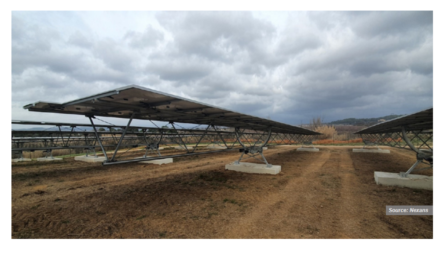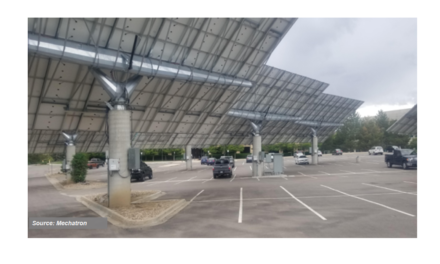- Solar tracker manufacturers are using advanced control strategies and algorithms to improve the energy output of solar power plants
- Algorithms consider factors such as row-to-row tracking, diffused light and terrain relief to optimize energy production
- Advanced control strategies, such as adapting backtracking based on 3D modelling and using real-time weather forecast are being explored to increase efficiency
While manual trackers were known to exist already long time ago, a lot has changed with today’s trackers (see Technology Trends In Solar Trackers). These fully automated devices are pretty smart making use of advanced algorithms and artificial intelligence. The algorithms are used to address several days to day challenges in operating a solar parks. After we have looked as part of our current series on Solar Trackers into details for tracking algorithms of TrinaTracker, we are now looking at such software used by other solar tracker suppliers (see A ‘SuperTrack’er).
Nextracker, for example is offering a self-adjusting tracking control system called TrueCapture basically helps enhance the power production of the solar plant. The algorithm basically takes into account two parameters—the row-to-row tracker and diffused light. Unlike standard backtracking algorithms that assume the site to be completely flat, TrueCapture breaks the system-wise algorithm into a row-to-row algorithm and optimizes each tracker’s position. The gain in energy is between 2% and 6%, according to Lubaba Mawas, Project Engineer at Nextracker. In the diffused light tracking mode, the algorithm drives the trackers into a flat position to produce more energy, rather than tracking the sun itself
Clenergy is also using a 3D shadow backtracking algorithm for rolling terrain. The traditional 2D shadow backtracking algorithm only considers the influence of theoretical row spacing and array width to calculate geometric shadow backtracking. However, the 3D shadow backtracking algorithm further considers the influence of terrain topographic relief and potential installation deviation between arrays, and provides an optimized solution. The control system of the company is also optimized for low light conditions and bifacial.
Clenergy is already offering optimized algorithms for the protection mechanism in severe weather conditions. The new wind protection mechanism will analyze and study the airfield of the whole power station, and activate the wind avoidance mechanism of specific arrays according to the wind distribution of each wind direction and the wind field distribution. The other arrays will still track and operate normally, so as to ensure the safety of the power station and continued power generation. The traditional wind protection mechanism of the tracker is that when the critical wind speed is detected, all the trackers will switch to the wind shelter state and stop rotating.
Clenergy has also optimized its strategy for bifacial. It recommends setting up test groups to capture best tracking tilts in real time through rapid rotation and combine the results with advanced search algorithms, machine learning algorithms and deep neural networks. By establishing a centralized search and distributed feedback on irradiation, best tracking tilt from the bifacial modules can be obtained.
Gonvarri Solar Steel also has a proprietary control software called TracSmarT+ with features such as real 3D backtracking technology and optimizations for different light conditions (direct, diffuse and albedo).
In the case of Antaisolar, while it currently uses the Solar Position Algorithm (SPA) for its trackers, it has a long list of advanced control strategies to be implemented in the future. The backtracking needs to be adapted as per 3D modeling based on the real terrain taking its undulations and slopes into account. As for the meteorological data input for tracker control, the company intends to adopt a cloud strategy based on real-time weather forecast and machine learning data. This can be accomplished by establishing a weather database, combining it with real-time weather data, and then obtaining the cloud image in real time and predicting the cloud projection area. The final steps would be to identify the projection area and manage the tracking methods of different irradiation areas. Taking input from the inverter using real-time IV characters of PV arrays as the feedback signal helps realize an AI tracker control strategy. The analysis of PV module/string performance with reference to pyranometer / albedometer data can also be added to the input pool. Anticipating adverse meteorological phenomena with greater precision and being prepared with a suitable defense position, an intelligent weather control station, dedicated control algorithm for half-cell modules and using LORA instead of Zigbee as the communication system are also part of the company’s check list (see Overview Of Solar Trackers).
FTC, on the other hand, likes to highlight its digital solutions. On the design front, the company offers SunDAT, which allows developers and EPCs to simulate several solar project design parameters to take decisions for best commercial outcomes. SunOPS is a platform that analyzes the asset management teams and O&M providers to identify performance gaps in real-time. Using this information, sites can efficiently plan for downtimes and optimize maintenance scheduling. SunPATH is the company’s performance focused program that limits the site’s energy losses from undulating terrain and on cloudy days through terrain-based backtracking and irradiance optimization algorithms. This allows EPCs to reduce the need for grading on hilly sites to meet energy targets.
The text is an excerpt from TaiyangNews 2nd Market Survey on Solar Trackers, which was published in Dec. 2022 and can be downloaded for free here.













